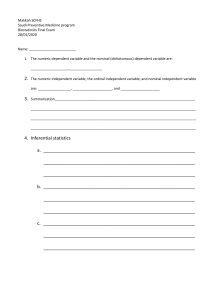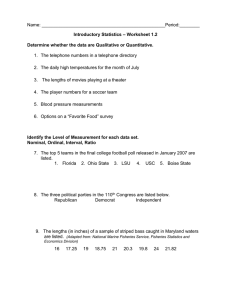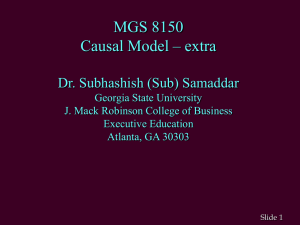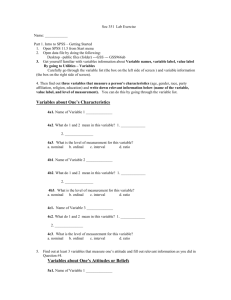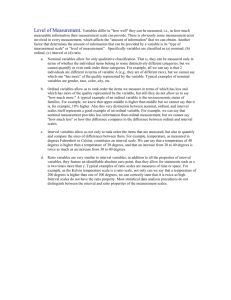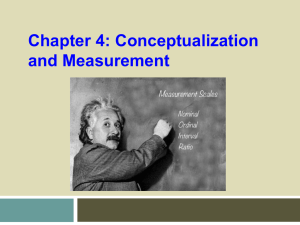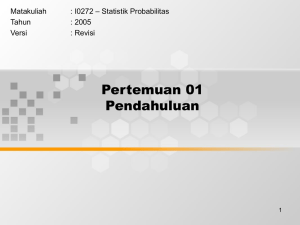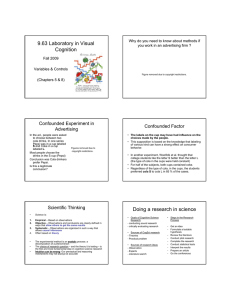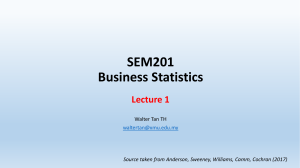Data and Statistics
advertisement
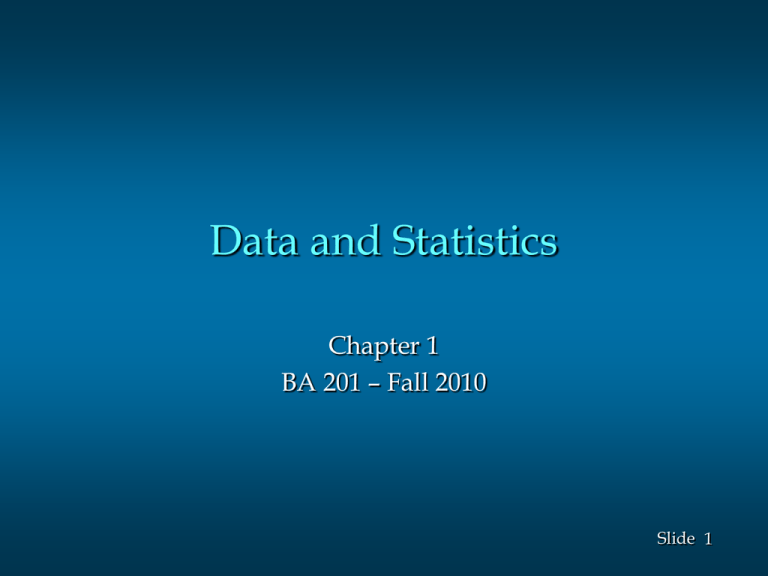
Data and Statistics Chapter 1 BA 201 – Fall 2010 Slide 1 Statistics Numerical facts such as averages, medians, percents, and index numbers. Art and science of collecting, analyzing, presenting, and interpreting data. Slide 2 Data and Data Sets Data are the facts and figures collected, analyzed, and summarized for presentation and interpretation. The data set is all the data collected in a particular study. Slide 3 Elements, Variables, and Observations Elements are the entities on which data are collected. A variable is a characteristic of interest for the elements. An observation is the set of measurements obtained for a particular element. Slide 4 Data Sets, Elements, Variables, and Observations Variables Elements Dataram EnergySouth Keystone LandCare Psychemedics Stock Exchange NQ N N NQ N Annual Earn/ Sales($M) Share($) 73.10 74.00 365.70 111.40 17.60 0.86 1.67 0.86 0.33 0.13 Data Set Slide 5 Scales of Measurement Nominal Ordinal Interval Ratio Slide 6 Scales of Measurement Nominal – labels or names. • E.g., CoB, CoST, CoAL, CoH; male or female; department 1, 2, 3, 4, … Ordinal - have the properties of nominal data and the order or rank of the data is meaningful. • E.g., Freshman, Sophomore, Junior, or Senior Slide 7 Scales of Measurement Interval – have the properties of ordinal data, and the interval between observations is expressed in terms of a fixed unit of measure. • E.g., ACT score of 23, 24, 25, …; years. • Numeric Ratio - have all the properties of interval data and the ratio of two values is meaningful. • E.g., 30 credit hours versus 120 credit hours • Must include zero Slide 8 What You Can Do With Scales Compute Frequency distribution. Median and percentiles. Add or subtract. Mean, standard deviation, standard error of the mean. Ratio or coefficient of variation. Nominal Ordinal Interval Ratio Yes Yes Yes Yes No Yes Yes Yes No No Yes Yes No No Yes Yes No No No Yes http://www.graphpad.com/faq/viewfaq.cfm?faq=1089 Slide 9 Categorical or Quantitative Data Categorical (or Qualitative) Grouped by categories Numeric or non-numeric Nominal or ordinal Quantitative How much or how many Numeric Interval or ratio More statistical tests available Slide 10 Scales of Measurement Data Categorical Numeric Nominal Ordinal Quantitative Non-numeric Nominal Ordinal Numeric Interval Ratio Slide 11 Cross-Sectional or Time Series Data Cross-sectional data are collected at the same or approximately the same point in time. • E.g., Building permits in January Time series data are collected over several time periods. • E.g., Building permits each month Slide 12 Data Sources Existing Sources – data already exists. Statistical Studies – data obtained through a study. • Experimental Studies – variable of interest identified and other variables controlled. • Observational studies – no attempt is made to control or influence the variables of interest. Slide 13 Descriptive Statistics Data summarized and presented in a form that is easy for the reader to understand. Tabular, graphical, or numerical. Average Tune-up = $79 Slide 14 Statistical Inference Use data from a sample to make estimates or test hypotheses about a population. Slide 15 Statistical Inference Population – set of all elements in a particular study. • Census – collects data about entire population. Sample – a subset of the population. • Sample survey – collects data for a sample. Slide 16 Statistical Inference Population Sample Statistics about the sample provide an estimate of the population. Statistics about sample Slide 17 Slide 18
